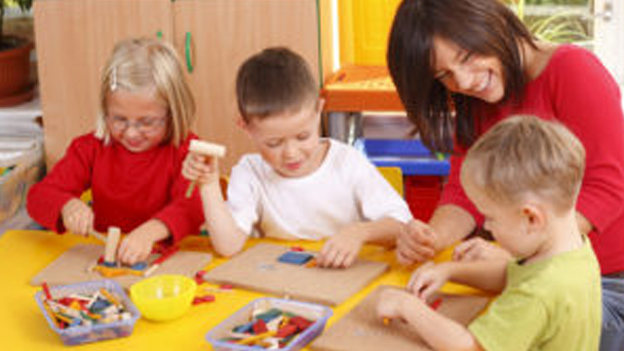Author Archives: lg_webadmin

5 Benefits of Attending Preschool
26 April, 2016
Preschool provides a foundation for the life of your child. Over three-fourths of young children in the United States participate in a preschool program, and finding the right preschool for your child is a task that should be taken with extreme consideration. Here are five reasons why preschool is beneficial to your child.
1. An opportunity for growth
For many children, attending preschool is their first experience in a structured setting with teachers and other children their age. It is an opportunity to socialize, follow instructions, and share, all of which provide a foundation for a high quality education they can expect in kindergarten.
2. Grade school readiness
Most parents are enrolling their child in preschool in order to put them on the path to success in school. Academic preschool programs will offer a child the opportunities of constructed playtime and high quality education. Preschool teachers understand the ways young children grow and learn, and develop activities to help them thrive during the day.
3. It has long term effects
Putting your child in a quality preschool program will shape the outcome of their life. Shockingly, 60% of at-risk children were found to be more likely not to go to college if they didn’t get a quality preschool education, with 25% being more likely to drop out of high school if they didn’t attend preschool.
4. Promotes social and emotional development
In order to learn, it is necessary for a child to feel as if they are cared for in a secure environment with a teacher or caregiver. Developing a bond with a teacher will help a toddler build trusting relationships with adults outside of their family while helping to nurture warm relationships among teachers and parents.
Additionally, children thrive when there is consistency in care between home and school. In high quality preschools, teachers communicate with parents so they can keep a universal teaching style. As a parent, you can expect to receive daily reports on your child’s progress along with regular meetings to discuss values and goals for your child.
5. Children get to make choices
An important skill to learn before entering kindergarten is to learn how to appropriately choose activities that match the child’s interests. This will lead to a child feeling more responsible and confident in their decisions.
Your child can only benefit from attending preschool. Enroll them today!

Learning How to Combat Summer Learning Loss
11 April, 2016
Summer learning loss — a phenomenon you may have heard of before. It’s not just a way to poke fun at how quickly kids forget everything they’ve learned once school is out — it’s a real, observed issue that occurs to millions of children every year.
Previous studies estimate that the average child forgets about 2.6 months of mathematics education and 2 months of reading. In fact, a percentage of the achievement gap in reading that occurs later in high school has been traced back to summer learning loss.
Why does this happen? The current school schedule is based on an outdated system. In the beginnings of the public school system, the majority of Americans were involved in agriculture. Today, few Americans work on farms — and yet the long break persists.
So how can you combat summer learning loss in 2016?
Enroll Your Child in Summer Learning
For younger children, taking an academic preschool curriculum over summer can help them prepare for the rigors of grade school. About 75% of kids in the U.S are currently enrolled in a preschool program, yet the summertime is often ignored. Getting children involved in grade school readiness during July and August allows for a more smooth and prepared transition into their first year of grade school.
Research All Your Local Options
According to a recent study by the Afterschool Alliance, many students and parents want summer learning programs — they just don’t always have access to them because of location or finances. Luckily, preschools often cater to a wide range of demographics, and about 45% of children living below the federal poverty level are currently enrolled in preschool. It’s easy to assume that no summer program will fit your family’s requirements, but in many cases, the right program is out there.
Things to Look for in a Preschool for the Summer
There’s a difference between daycare and preschool. Preschool focuses on grade school prep. Daycare, on the other hand, is essentially the same thing as babysitting. Look for preschool education activities that focus on encouraging scholastic growth. It’s worth noting that 60% of at-risk youth were found to be less likely to go to college if they didn’t receive a quality preschool experience.
Make Frequent Trips to the Library
Not everything you do to combat summer learning loss needs to be a massive undertaking; sometimes, it can be as simple as visiting your local library. Middle income students actually experience slight gains in reading over the summer compared to their peers — and this typically relates back to the ability to access books through a library or bookstore. Preschool education activities often include reading time.
Whether it’s preschool education activities like reading a new book, or attending a summer learning class, there are ways to cut down on the effects of summer learning loss.

What’s the Difference Between a Preschool and a Daycare?
11 April, 2016
Preschool, daycare, what’s the difference? They are both just places to drop off your kid when you go to work, right? Wrong.
More and more parents are discovering the benefits of academic preschool, and how a strong academic preschool curriculum can set their children up for grade school readiness.
A daycare center is a place that provides supervision of young children when parents are busy or at work. The settings may look similar: a building with a playground, bright colored rooms with art supplies, toys, and cheerful music. The activities may even appear to be the same — drawing, coloring, dancing, building, singing — but the difference is in the purpose of these activities and the dedication of the supervising adults.
A teacher at a preschool is not a babysitter. The teacher’s primary role is to create a stimulating environment for the children in which they will be learning and cultivating important life skills. Oftentimes, this learning is conducted through play, but the games and academic preschool activities are designed to provide children with an experience that will foster personal growth.
By contrast, a daycare worker’s job is to ensure the children’s safety and keep them occupied while they wait for their parents’ to pick them up. Learning can certainly happen at a daycare facility, but it is not the purpose, and the daycare workers are not trained to educate, but rather to care-take.
As many as three-fourths of children in the United States attend an academic preschool program. The percentage of children between the ages of three and five enrolled in these programs increased from 59% to 65% Between 1990 and 2013. The number continues to grow today as studies have shown the positive effects an academic preschool curriculum has had on participating children.
One study showed that one-fourth of at-risk kids were more likely to drop out of high school if they did not get a quality preschool education. Furthermore, 70% of at-risk children were more likely to be arrested for committing a violent crime if they did not attend a quality preschool.
The academic preschool curriculum does not directly deter children from committing crimes or staying in school, but it does instill in them an interest in learning. When a child starts at a young age, she is more likely to understand the importance of education; when education is mixed with fun and play, she may develop of love of learning and even a love for school.

The Long-Term Benefits of Enrolling At-Risk Youth in Preschool
17 February, 2016


